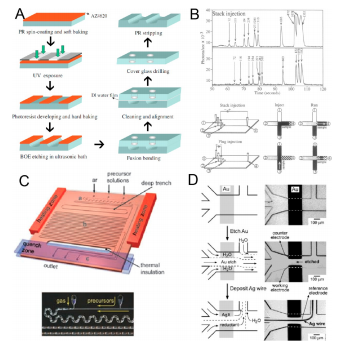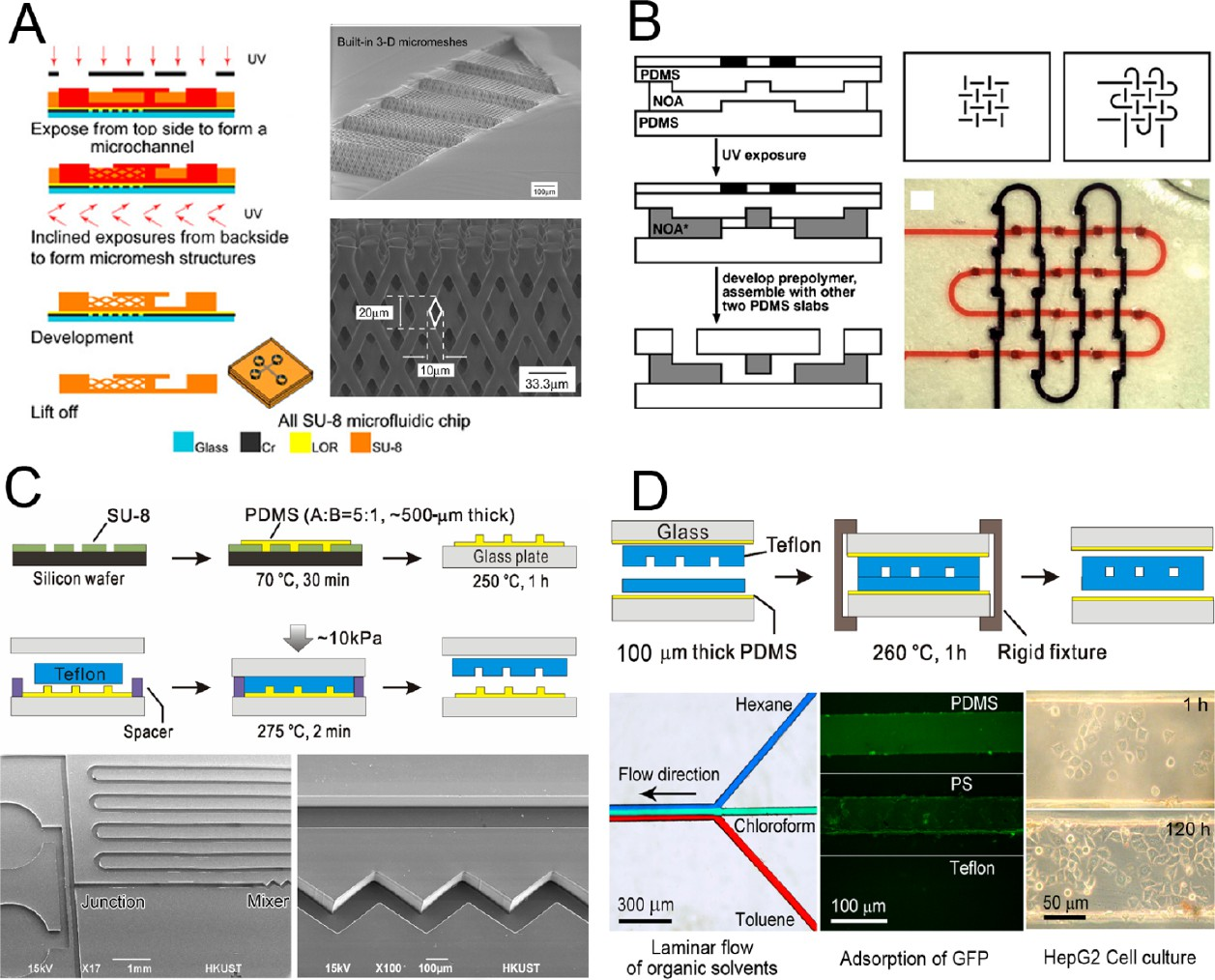CONSPECTUS
Through manipulating fluids using microfabricated channel and chamber structures, microfluidics is a powerful tool to realize high sensitive, high speed, high throughput, and low cost analysis. In addition, the method can establish a well-controlled microenivroment for manipulating fluids and particles. It also has rapid growing implementations in both sophisticated chemical/biological analysis and low-cost point-of-care assays. Some unique phenomena emerge at the micrometer scale. For example, reactions are completed in a shorter amount of time as the travel distances of mass and heat are relatively small; the flows are usually laminar; and the capillary effect becomes dominant owing to large surface-to-volume ratios. In the meantime, the surface properties of the device material are greatly amplified, which can lead to either unique functions or problems that we would not encounter at the macroscale. Also, each material inherently corresponds with specific microfabrication strategies and certain native properties of the device. Therefore, the material for making the device plays a dominating role in microfluidic technologies. In this Account, we address the evolution of materials used for fabricating microfluidic chips, and discuss the application-oriented pros and cons of different materials.
1. Inorganic Materials
Before the concept of “microfluidics” was introduced, microchannels had already been used, for example, glass or quartz capillaries for gas chromatography and capillary electrophoresis (CE), and flow reactors micromachined in metal; they contributed to the incubation of microfluidics. Sparked by the microfabrication technologies in the semiconductor industry, the first-generation microfluidic chips were prepared in silica or glass.
Silica and glass is normally processed with standard photolithography (Figure 1A):15 a thin layer of photoresist is applied to the wafer and subjected to an ultraviolet exposure, which transfers the micropattern on a transparency mask to the photoresist layer; the photoresist is developed to generate a mask for etching; after microchannels are formed, the photoresist is removed and the channels are sealed with a flat substrate, for example, through a fusion bonding process. Differently, photosensitive glass (rarely used glass in the field) can form microchannels with laser direct writing (LDW),16 However, LDW is serial-processing (thus is slow) and relies on expensive equipment.

FIGURE 1. (A) Fabrication of glass microchips using wet-etching and fusion bonding methods. (B) Rapid separation on glass microfluidic chip with CE. (C) High-temperature reaction in microdroplets on a glass chip. (D) In-situ metal etching and deposition on a glass substrate using laminar flow. Panel (A) reproduced with permission from ref 15. Copyright 2001 IPO Publishing. Panel (B) reprinted from ref 18. Copyright 1994 National Academy of Sciences. Panel (C) reprinted with permission from ref 19. Copyright 2005 John Wiley and Sons. Panel (D) reprinted with permission from ref 20. Artwork originally published in Science 1999, 285, 83 85. Copyright 1999 American Association for the Advancement of Science.
2. Elastomers and Plastics
Polymer-based chips were introduced several years later after silicon/glass chips. The vast variety of polymers offers great flexibility in choosing suitable material with specific properties.Compared with inorganic materials, polymers are easy to access and inexpensive, and therefore have become the most-commonly used microchip materials. According to their physical properties, polymers can be classified into three groups: elastomers, thermosets, and thermoplastics.

FIGURE 2. (A) Microchannel made entirely with SU-8, with in situ fabricated 3D fine structures. (B) 3D microfluidic channel fabricated in thermoset NOA. (C) Microfabrication of thermoplastics with high temperature transfer molding method. (D) Microfluidic chip fabricated entirely using Teflon PFA. Panel (A) reprinted with permission from ref 43. Copyright 2006 IOP Publishing. Panel (B) reprinted with permission from ref 44. Copyright 2010 AIP Publishing. Panels (C) and (D) reproduced from ref 46. Copyright 2010 National Academy of Sciences.
Two particular perfluorinated polymers, perfluoroalkoxy (Teflon PFA) and fluorinated ethylenepropylene (Teflon FEP), are thermoprocessable and can be used for microfluidic structures. All Teflons are extremely inert to chemicals and solvents, and ultimately nonsticky and antifouling. Importantly, they are optically transparent, soft enough to make diaphragm valves, and moderately permeable to gases. Although their melting temperatures are high (over 280), with the high-temperature thermomolding techniquementioned above,45we can generate delicatemicrostructures with nanometer resolution in them and thermally bond them to form various microfluidic devices.46 The resulting whole-Teflon chips show excellent compatibility with organic solvents, outstanding antifouling properties, and amenability for cell culture (Figure 3D).
Conclusions and Outlook
The evolution of chip materials reflects the two major trends of the microfluidic technology: powerful microscale research platforms and low-cost, portable analyses. For laboratory research, choosing materials generally needs to compromise the ease in prototyping and the performance of device, while in commercialization the major concerns are the cost of production and the ease and reliability in use. Such difference leads to varied preference in materials for device fabrication. Current trends seem to be that glass/silicon and PDMS are commonly used in research laboratories while plastics and paper are more promising for commercial devices. Each material has its pros and cons. Glass, silicon, and Teflon represent the most inert materials to chemicals and solvents; PDMS is easy to prototype and to fabricate complicated fluid circuits with various integrated components; normal thermoplastics are excellent for commercial mass production of standard microfluidic devices; hydrogels are more suitable for biological applications; and paper is highly promising for commercial disposable bioassays (Table 2). Finally, all the materials can be modified or combined to fabricate more powerful devices for specific aims.